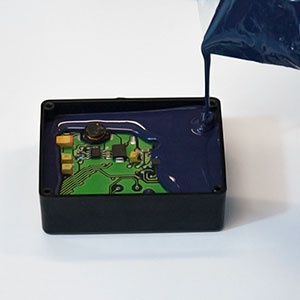Resins are widely used for potting and encapsulation in the electronics and electrical industries, and are generally found in three major categories, depending on their chemical types: epoxy, urethane and silicone. Electrolube develops, manufactures and supports a wide variety of resin products within these categories.
Epoxy Resin Properties
Epoxy resins enjoy wide popularity among electronics industries due to their excellent electrical and mechanical properties, as well as their ability to offer protection against chemicals and high temperatures. Their use enables electrical components to be protected against dust, moisture and short circuits, and as standard epoxy resins have better thermal conductivity than air, they provide more efficient dissipation of heat from components, thus prolonging service life.
Today there are a wide range of different epoxy based resin systems available, offering a wide range of different properties. The curing process for epoxy resins is generally slow, but a range of different cure speeds and cured properties can be obtained using amines, amine modified polymers or polyamides. However, while the reaction can be very fast, it can also be very exothermic, leading to the possibility of a runaway reaction. This can be mitigated by modifying the resin’s amine chemistry or by using a filler, which will help absorb the heat of reaction and which is often used as a flame retardant. Note here that the temperature at which a resin is cured will affect not only its cure speed, but also the quality of the end result, so it’s as well to carry out some trials before committing to a specific cure rate.
One of the newest epoxy resins from Electrolube, which was featured at Electronica 2016, is a modified formulation of the company’s ER4001 thermally conductive epoxy resin system, offering an improved method of cure and subsequent health and safety benefits for the user. This resin is particularly suited to automotive applications (for both traditional and electric power) that generally require high thermal conductivity and good thermal cycling performance. The improved ER4001 is also ideal for use in LED lighting units where it helps to promote heat dissipation and prolong unit service life.
Electrolube’s epoxy resin portfolio includes a variety of clear, white and black single- and two-part products with a host of useful properties to meet most requirements from potting and sealing to dipping, including exceptional electrical and thermal characteristics, flame retardancy and resistance to chemicals and fuels.
Polyurethane Resin Properties
 While epoxy resins provide a hard and inflexible encapsulation when cured, polyurethane resins are elastomeric or rubbery in their cured state, which is particularly useful if the circuit to be potted contains delicate components. Like epoxy resins, polyurethane resins provide chemical, dust and moisture resistance, as well as excellent electrical insulation and good adhesion to most substrates, both metal and plastic. And unlike their epoxy counterparts, polyurethanes have a lower exotherm during cure, even for fast cure systems. However, cured polyurethane resins should not be allowed to rise above 130°C continuous service temperature
While epoxy resins provide a hard and inflexible encapsulation when cured, polyurethane resins are elastomeric or rubbery in their cured state, which is particularly useful if the circuit to be potted contains delicate components. Like epoxy resins, polyurethane resins provide chemical, dust and moisture resistance, as well as excellent electrical insulation and good adhesion to most substrates, both metal and plastic. And unlike their epoxy counterparts, polyurethanes have a lower exotherm during cure, even for fast cure systems. However, cured polyurethane resins should not be allowed to rise above 130°C continuous service temperature
Electrolube’s newest polyurethane resins, which were also showcased at Electronica, are specifically aimed at helping LED lighting manufacturers provide environmental protection for their products. UR3638 is a tougher and low exotherm version of its 3634 product, providing a clear, transparent finish. The low exotherm of this resin makes it particularly suitable for applications involving the encapsulation of larger LED lighting units. It is an aliphatic polymer offering superior UV stability as well as excellent transmission of visible light, making it an ideal resin for white light LEDs.
The second new polyurethane resin is a low exotherm, low viscosity, low hardness, flexible, clear/transparent resin designed for encapsulating a variety of electrical components, but particularly LEDs. The level of flexibility achieved by the cured resin means that the connecting legs of components are not placed under high levels of stress during the cure.
Electrolube's polyurethane resins come in white, black, blue, clear straw, hazy/cloudy and optically clear formulations and, in common with the epoxy range, offer a host of properties to meet the needs of high-temperature environments and those exposed to chemical contamination, mechanical stress or shock and moisture ingress.
Silicone Resin Properties
As with some types of polyurethane resin, optically clear silicone resins, such as Electrolube's SC3001, have superior resistance to UV light, and have been shown to maintain their clarity throughout rigorous laboratory exposure testing regimes. This well-documented UV resistance makes them ideal for LED applications where resin colour stability is important to achieving minimal colour temperature shift of the LED lighting unit itself.

Though not as popular as epoxy and polyurethane resins, silicone resins do offer some distinct advantages when used as an encapsulating resin because the cured products have a high degree of flexibility, excellent chemical, dust and moisture resistance, and good electrical insulating properties. Silicone resins tend to be more expensive than epoxies or polyurethanes, but are ideally suited where high continuous operating temperatures (above 180°C) are required. Moreover, the exothermic temperature when working with silicone systems is very low indeed, ensuring compatibility with heat-sensitive components.
In contrast to the polyurethane curing mechanism, silicone curing requires the presence of water to initiate the cure process. The reaction takes place at room temperature – often referred to as ‘room temperature vulcanisation’ (RTV) – but the resin can take between 24 and 48 hours to fully cure, dependent upon the potting depth or sample thickness. Silicone resins also demonstrate excellent adhesion to most substrates, including both metals and plastics.
In addition to the SC3001 optically clear two-part silicone potting resin, Electrolube also supplies the SC2001 general purpose dark grey compound (together)
Conclusion
The majority of Electrolube resins are two part systems that, when mixed together in the correct ratio, react to form polymeric materials. By careful formulation, the properties of the cured resin can be tailored to meet individual customer requirements. If you would like to learn more about Electrolube’s new generation of resin products or how Electrolube can develop products to meet your specific needs, the company’s international team of technical experts are always on hand to answer your questions.
Alistair Little, Technical Director of Electrolube’s global resins business



